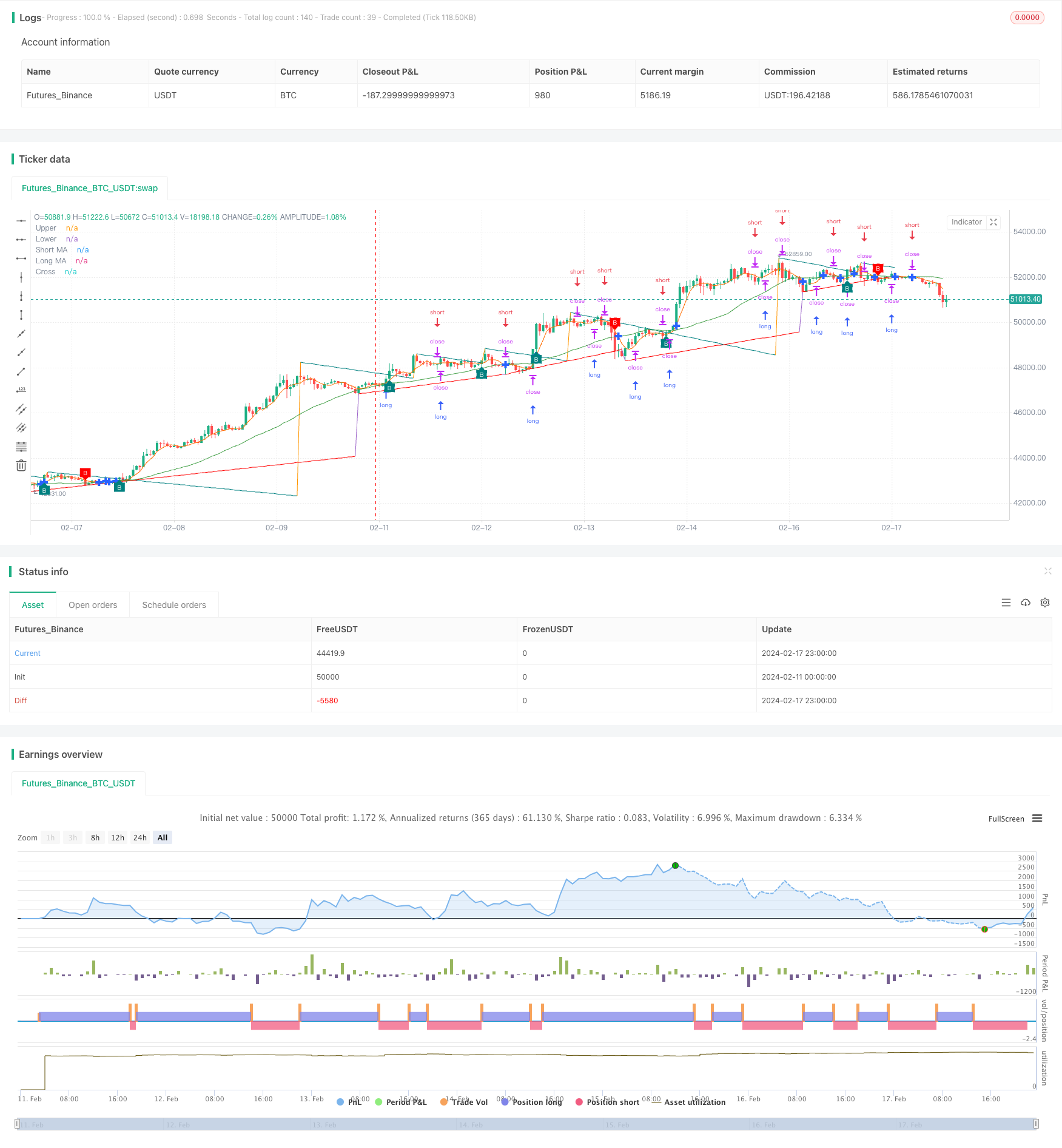
概述
双重趋势突破策略综合运用了多种技术指标,主要包括趋势线、均线交叉和价格通道突破,旨在识别市场趋势变化,捕捉趋势反转机会。该策略结合趋势跟踪和突破信号,进出仓比较稳健,但也存在一定的假突破风险。
策略原理
趋势线
该策略首先使用枢轴高点和枢轴低点划分多空趋势,当价格突破趋势线时,表示潜在的趋势反转。计算斜率采用ATR方法,使其更贴近实际波动。
均线交叉
该策略采用短期5日线和长期34日线,构建快慢均线交叉策略。短均线上穿长均线为买入信号,下穿为卖出信号。利用快速均线捕捉短期趋势,慢速均线跟踪长期趋势。
价格通道
该策略还设置了一个5日的价格通道,突破上轨买入,突破下轨卖出,捕捉短期价格突破。结合快慢均线决定突破的可靠性。
上述三种技术指标信号综合运用于该策略,形成稳健的双重判断机制,避免错误交易。
策略优势
多种技术指标集成,判断信号较为稳健,减少了假突破造成的损失。
快速均线和价格通道能够及时抓住短期价格趋势变化。慢速均线和趋势线跟踪长期趋势,进出场比较稳定。
代码结构清晰,指标参数可调整,可以针对不同周期、品种进行调整优化。
结合了趋势判断和突破信号,在趋势牛市中,行情较为激进有利于获利;在范围整理中,突破信号交易频次会降低,有利于规避大幅震荡。
策略风险
存在一定的假突破风险,特别是在价格震荡整理的场景,容易造成亏损。
均线交叉属于滞后信号,若大幅趋势反转就会存在追高买入或割低卖出的风险。
多种技术指标集成,在参数优化时需要大量测试和计算,较为耗时。
针对假突破风险,可以加入成交量指标进行过滤,例如突破时需成交量放大,或某一根K线收盘价未突破前高或前低等。
针对追高买入风险,可以设置超买超卖指标的过滤条件,例如RSI指标避免超买。或设置止损线,加快止损。
针对参数优化难题,可以采用机器学习方法辅助寻优,在大量历史数据中寻找最优参数组合。
策略优化
加入成交量指标或者超买超卖指标判断趋势可靠性,设置严格的过滤条件,避免假突破造成亏损。
针对不同的交易品种,调整均线参数设置和价格通道参数使其更贴合该品种的特性。
增加止损策略,通过移动止损、挂单止损等手段控制单笔亏损。
采用适应性方法,当市场进入震荡整理阶段,降低开仓频次;趋势明显时增加交易频次。
利用深度学习方法训练模型判断买卖点,辅助或替代传统技术指标,利用深度学习泛化能力寻找更有效的交易策略。
总结
本策略整合多种常用技术指标形成双重判断体系,能够有效识别趋势变化,在回测中表现出较好的稳定性。但也应该注意一定的假突破风险,通过增加过滤条件、止损策略、参数调整和运用机器学习方法进行优化,能够进一步增强策略的实盘表现。
/*backtest
start: 2024-02-11 00:00:00
end: 2024-02-18 00:00:00
period: 1h
basePeriod: 15m
exchanges: [{"eid":"Futures_Binance","currency":"BTC_USDT"}]
*/
// This Pine Script™ code is subject to the terms of the Mozilla Public License 2.0 at https://mozilla.org/MPL/2.0/
// © FinanceUpPvtLtd
//@version=5
strategy("FINANCE UP FREE STRATEGY (+919665229664)", overlay=true)
// Script 01 - Trendlines
length_tl = input.int(14, 'Swing Detection Lookback')
mult_tl = input.float(1., 'Slope', minval=0, step=.1)
calcMethod_tl = input.string('Atr', 'Slope Calculation Method', options=['Atr', 'Stdev', 'Linreg'])
backpaint_tl = input(true, tooltip='Backpainting offset displayed elements in the past. Disable backpainting to see real-time information returned by the indicator.')
upCss_tl = input(color.teal, 'Up Trendline Color', group='Style')
dnCss_tl = input(color.red, 'Down Trendline Color', group='Style')
showExt_tl = input(true, 'Show Extended Lines')
var upper_tl = 0.
var lower_tl = 0.
var slope_ph_tl = 0.
var slope_pl_tl = 0.
var offset_tl = backpaint_tl ? length_tl : 0
n_tl = bar_index
src_tl = close
ph_tl = ta.pivothigh(length_tl, length_tl)
pl_tl = ta.pivotlow(length_tl, length_tl)
slope_tl = switch calcMethod_tl
'Atr' => ta.atr(length_tl) / length_tl * mult_tl
'Stdev' => ta.stdev(src_tl, length_tl) / length_tl * mult_tl
'Linreg' => math.abs(ta.sma(src_tl * n_tl, length_tl) - ta.sma(src_tl, length_tl) * ta.sma(n_tl, length_tl)) / ta.variance(n_tl, length_tl) / 2 * mult_tl
slope_ph_tl := ph_tl ? slope_tl : slope_ph_tl
slope_pl_tl := pl_tl ? slope_tl : slope_pl_tl
upper_tl := ph_tl ? ph_tl : upper_tl - slope_ph_tl
lower_tl := pl_tl ? pl_tl : lower_tl + slope_pl_tl
var upos_tl = 0
var dnos_tl = 0
upos_tl := ph_tl ? 0 : close > upper_tl - slope_ph_tl * length_tl ? 1 : upos_tl
dnos_tl := pl_tl ? 0 : close < lower_tl + slope_pl_tl * length_tl ? 1 : dnos_tl
// var uptl_tl = line.new(na, na, na, na, color=upCss_tl, style=line.style_dashed, extend=extend.right)
// var dntl_tl = line.new(na, na, na, na, color=dnCss_tl, style=line.style_dashed, extend=extend.right)
// if ph_tl and showExt_tl
// uptl_tl.set_xy1(n_tl - offset_tl, backpaint_tl ? ph_tl : upper_tl - slope_ph_tl * length_tl)
// uptl_tl.set_xy2(n_tl - offset_tl + 1, backpaint_tl ? ph_tl - slope_tl : upper_tl - slope_ph_tl * (length_tl + 1))
// if pl_tl and showExt_tl
// dntl_tl.set_xy1(n_tl - offset_tl, backpaint_tl ? pl_tl : lower_tl + slope_pl_tl * length_tl)
// dntl_tl.set_xy2(n_tl - offset_tl + 1, backpaint_tl ? pl_tl + slope_tl : lower_tl + slope_pl_tl * (length_tl + 1))
plot(backpaint_tl ? upper_tl : upper_tl - slope_ph_tl * length_tl, 'Upper', color=ph_tl ? na : upCss_tl, offset=-offset_tl)
plot(backpaint_tl ? lower_tl : lower_tl + slope_pl_tl * length_tl, 'Lower', color=pl_tl ? na : dnCss_tl, offset=-offset_tl)
plotshape(upos_tl > upos_tl[1] ? low : na, "Upper Break", shape.labelup, location.absolute, upCss_tl, text="B", textcolor=color.white, size=size.tiny)
plotshape(dnos_tl > dnos_tl[1] ? high : na, "Lower Break", shape.labeldown, location.absolute, dnCss_tl, text="B", textcolor=color.white, size=size.tiny)
alertcondition(upos_tl > upos_tl[1], 'Upward Breakout', 'Price broke the down-trendline upward')
alertcondition(dnos_tl > dnos_tl[1], 'Downward Breakout', 'Price broke the up-trendline downward')
// Script 02 - Channel Breakout
length_channel = input.int(title="Channel Length", minval=1, maxval=1000, defval=5)
upBound_channel = ta.highest(high, length_channel)
downBound_channel = ta.lowest(low, length_channel)
if (not na(close[length_channel]))
strategy.entry("LE-LE", strategy.long, stop=upBound_channel + syminfo.mintick, comment="LE-LE")
strategy.entry("BECH-DE", strategy.short, stop=downBound_channel - syminfo.mintick, comment="BECH-DE")
// Script 03 - MA Cross
shortlen_ma = input.int(5, "Short MA Length", minval=1)
longlen_ma = input.int(34, "Long MA Length", minval=1)
short_ma = ta.sma(close, shortlen_ma)
long_ma = ta.sma(close, longlen_ma)
plot(short_ma, color=#FF6D00, title="Short MA")
plot(long_ma, color=#43A047, title="Long MA")
plot(ta.cross(short_ma, long_ma) ? short_ma : na, color=#2962FF, style=plot.style_cross, linewidth=4, title="Cross")